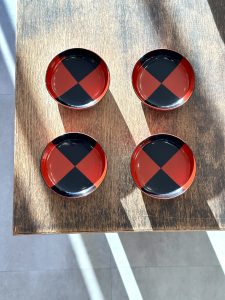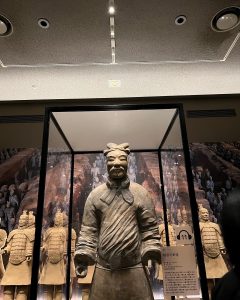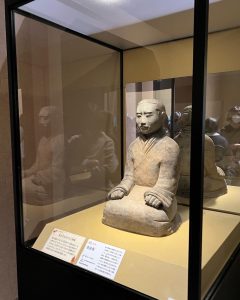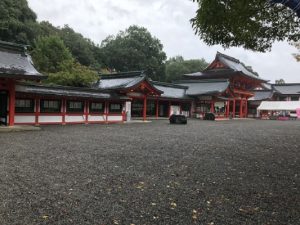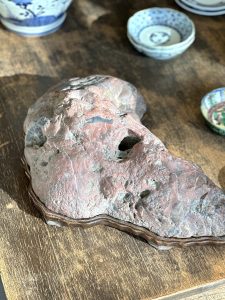こんにちは、スタッフNでございます。
涼しくなったと思ったら、また27度まで気温が上がりましたね。
寒かったり暑かったり、体調がすぐれない方もたくさんいらっしゃると思います。
純ココア、マヌカハニー、しょうがなどで体を温めてくださいね。
先日知人が大量にショウガを購入していまして、何をするのかと聞きましたら、ジンジャーシロップをつくるそうです。
簡単だし、体も温まるし、この時期にぴったりですね。
少し暖かくなったからか、古美術風光舎の玄関先にも蜘蛛やらコオロギやら小さいお客様がいらっしゃいました。
普段じっくり見ることもないので、蜘蛛を近くで見てみますと、何やら歩きながら一生懸命前足を口に運んでおりまして、調べてみると、小さいダニなどを食べているそうです。
毒蜘蛛だったらどうしようと思いましたが、お掃除をしてくれているようで一安心です。
お疲れ様でございます。
外を眺めながらブログを書いておりましたら、園児たちが防災頭巾をかぶって歩いておりました。
避難訓練でしょうか?それにしても、小さい体に大きな頭巾をかぶっていると可愛らしくて笑ってしまいます。訓練なのだから笑ってはいけないのですが、なんとも微笑ましい姿でございました。
さて、先日Nの大好きなシャインマスカットを大量にいただきました。

段ボールにこんなにいただいたのに、あっという間になくなってしまいました。
一人暮らしをしていた頃は、シャインマスカットどころかフルーツも買えませんでしたので、ひとつぶひとつぶ感謝をこめて大切にいただこうと思います。
先日、インドの神様と桃についてお話しましたが、葡萄も絵画や美術品でよく見かけますよね。
今回は、そんな葡萄と美術品について調べてみました。
ぶどうの木は、複雑な象徴主義に陥りがちなロマネスク美術よりも、初期キリスト教美術、ゴシック美術において頻繁に用いられます。
ぶどうの木があらわす象徴は聖書の慣用ではまず、あらゆる果実同様、祝福であり、呪いでございます。
また、平穏、安全を意味する財産、迫りくる審判を象徴致します。
さらに ぶどうの木は イスラエルの民の象徴です。
ぶどうの木の下で働く者(ぶどう作り、ぶどう摘み、ぶどう搾り)はさまざまなたとえ話に登場致します。
美術イコン(イエス・キリスト、聖人、天使、聖書における重要出来事やたとえ話、教会史上の出来事を画いた画像)において特に好んで主題として選ばれるのは、イエスが自らをぶどうの木(生命の木)に例えた言葉です。
この葡萄の木には使徒たちが座っていることもございます。
この木が十字架の形で描かれることも多く、生命の木、十字架の象徴も含んでおります。
しばしばエロースによって行われるぶどうの収穫は最後の審判を暗示するものです。
フランス、ドイツのぶどう栽培地域では守護聖人としてランブルの聖ウルバーヌスの彫像が好んで置かれております。
ロマネスク美術においては、特にアプシス(中世の教会堂建築において、末端の内陣部を形成する突出部分)の柱頭の上で、しばしば跪いてほほえんでいる若い人々の手の中にブドウの房がある場合は、楽園の至福の時を楽しむ選ばれた人々を意味します。
12‐18世紀には、カンナの地から戻った軍人が、2人がかりで運ばねばならなかったほどの大きなブドウの房がしばしば表現されております。
ぶどうの房は予型論(ユダヤ教、キリスト教において古くから一般的に行われている聖書解釈法の一つ)上は十字架を担うキリストと結びつけられることが多いです。
それはキリストが十字架で流した血が教会の杯を満たしたという意味で、汁を搾られるぶどうに似ているからでございます。
さらにぶどうがぶどう酒になる前に切り取られ、圧搾されることは、この世の苦しみと死に対応していると同時に、より高い生命への意向を示しています。
この意味でブドウの房と葡萄酒は穀物だねとパンとの関係に似ており、生産におけるキリストを示す象徴として用いられるようになりました。
パレスチナの重要な特産物であり、またそれを飲む楽しみは、聖書や聖書が基にしているイスラエルの民衆の生活の中で重要な役割をはたしております。
ぶどう酒という語は聖書の中に200回以上、ぶどうの山という語は100回以上用いられております。
ぶどう酒は革袋や甕の中に入れて保存され、祭や供犠においては絶対に欠かせないものです。
ノアがぶどうを栽培し、ぶどう酒を飲んで酩酊したという話は、酔って自制を失うことに対する警告、ノアの息子ハブの行動は、後に兵卒たちがイエスに加えた暴行と同様、不敬の念を象徴しております。
ぶどう酒をキリストの地とする考え方は旧約聖書における生贄に代わるものとして生まれました。
カナの婚礼におけるぶどう酒の奇蹟は、しばしば美術の主題とされますが、そこではイエスの栄光が啓示されております。
ぶどうの古名(古い呼び方)は海老らしいのですが、日本に自生していた和種のブドウ科植物と似ていたため、葡萄(えび)というようになったそうです。 山葡萄のような赤紫色を、葡萄色(えびいろ)とも呼ぶそうです。
伝承では、日本にブドウが渡来したのは奈良時代のことで、 原産地からシルクロードを経て、唐から渡来したとされます。
718年(養老2年)、各地を行脚した高僧・行基が、甲斐国勝沼(山梨県甲州市(旧・勝沼町))の柏尾山大善寺に薬種園を設け、そこでブドウ(甲州種)の栽培を始めたそうです。
シャインマスカットは、実は日本生まれのぶどうで、1988年に広島県の農研機構が「安芸津21号」と「白南」の交配によって生み出し、2006年に品種登録されました。
いただいたシャインマスカットから、壮大なキリスト教の話になってしまいました。
普段何気なく食べていた葡萄、絵画にそんな意味があったとは驚きです。
古美術風光舎では葡萄モチーフの絵画なども買取しております。
皆さまも是非、身近にある葡萄の美術品を探してみてくださいませ。
ではでは
Hello, this is Staff N.
When I thought it was getting cooler, the temperature rose to 27 degrees again.
I think there are many people who are cold or hot and are not feeling well.
Warm up your body with pure cocoa, manuka honey, ginger, etc.
An acquaintance bought a lot of ginger the other day, and when I asked him what he was doing, he said he would make ginger syrup.
It’s easy, it warms the body, and it’s perfect for this time of year.
Perhaps because it was a little warmer, there were spiders, crickets, and other small customers at the entrance of Antique Fukousha.
I don’t usually look closely at the spider, so when I looked at the spider up close, I saw that it was carrying its front legs with all its might while walking, and that it was eating small mites.
I thought about what to do if it was a poisonous spider, but I’m relieved that it seems to be cleaning.
you have worked very hard.
When I was writing a blog while looking outside, some kindergarteners were walking around wearing disaster prevention hoods.
Is it an evacuation drill? Even so, wearing a large hood on a small body is cute and makes me laugh. I shouldn’t laugh because it’s training, but it was a smile.
Well, the other day, I received a large amount of N’s favorite Shine Muscat.
I received so much in cardboard, but it disappeared in no time.
When I was living alone, I couldn’t even buy Shine Muscat, let alone fruit, so I would like to take care of each and every one of them with gratitude.
The other day, I talked about Indian gods and peaches, but grapes are often seen in paintings and works of art, aren’t they?
This time, I tried to find out about such grapes and works of art.
The vine is used more frequently in early Christian and Gothic art than in Romanesque art, which tends to be prone to complex symbolism.
The symbol that the vine represents, in biblical usage, is primarily a blessing and a curse, like all fruit.
It also symbolizes wealth, which means peace and security, and impending judgment.
She further said that the vine is a symbol of his Israelites.
Those who work under the vine (grape-grower, grape-picker, grape-press) are mentioned in many parables.
A favorite subject of artistic iconography (images depicting Jesus Christ, saints, angels, important biblical events and parables, and events from ecclesiastical history) is the subject of Jesus representing himself on the vine (the tree of life). ).
The apostles are also seated in this vine.
This tree is often depicted in the form of a cross, including the tree of life and the symbol of the cross.
The grape harvest, often carried out by Eros, is an allusion to the Last Judgment.
In French and German wine-growing regions, the patron saint is the statue of Saint Urban of Lambre.
In Romanesque art, especially when there is a cluster of grapes in the hands of a young person kneeling and smiling, especially on the capital of an apsis , means the chosen people who enjoy the bliss of paradise.
In the 12th to 18th centuries, bunches of grapes so large that soldiers returning from the land of Canna had to carry them with two men are often depicted.
The bunch of grapes is often associated with Christ carrying the cross in typology (one of the commonly used interpretations of the Bible in Judaism and Christianity).
This is because the blood that Christ shed on the cross filled the cup of the church, and is similar to grapes being squeezed.
Moreover, the cutting and pressing of the grapes before they become wine correspond to the suffering and death of this world, while at the same time showing the intention to a higher life.
In this sense, the bunch of grapes and the wine are similar to the relationship between the grain and the bread, and have come to be used as symbols of Christ in production.
An important Palestinian specialty, the enjoyment of drinking it plays an important role in the Bible and the life of the people of Israel on which it is based.
The word wine is used over 200 times in the Bible and the word mountain of grapes over 100 times.
Wine is preserved in leather bags and jars, and is an essential part of festivals and sacrifices.
The story of Noah planting grapes and getting drunk with wine is a warning against drunkenness and losing control, and the actions of Noah’s son Hab, as well as the violence that the soldiers later inflicted on Jesus, are disrespectful. It symbolizes
The idea of wine as the land of Christ arose as an alternative to the Old Testament sacrifice.
The miracle of the wine at the wedding at Cana, often the subject of art, reveals the glory of Jesus.
The ancient name of grapes (old name) seems to be shrimp, but it seems that it came to be called grapes (ebi) because it resembled a Japanese grapevine plant that grew naturally in Japan. It seems that the reddish purple like wild grapes is also called Ebi-iro.
According to tradition, grapes were brought to Japan in the Nara period, and it is said that they came from the country of origin via the Silk Road and from Tang.
In 718 (Yoro 2nd year), the high priest Gyoki, who traveled around various places, built a medicinal plant at Mt. It seems that I started
Shine Muscat is actually a grape that originated in Japan. It was created in 1988 by the National Agriculture and Food Research Organization of Hiroshima Prefecture by crossing “Akitsu No. 21” and “Hakunan,” and was registered as a variety in 2006.
From the Shine Muscat I received, it turned into a magnificent Christian story.
It is surprising that the grapes that I usually eat casually and paintings have such a meaning.
At Antique Fukousha, we also purchase paintings with grape motifs.
Please try to find the works of art of grapes that are close to you.
See you soon
*********************
ご実家の整理やお片付けなどをされている方のご相談などが多くございます。朝晩少々お寒くなってまいりましたので、お片付けなどくれぐれもご無理のないようになさってくださいませ。
風光舎では古美術品や骨董品の他にも絵画や宝石、趣味のお品など様々なジャンルのものを買受しております。
お片付けをされていて、こういうものでもいいのかしらと迷われているものでも、どうぞお気軽にご相談下さいませ。
また風光舎は、出張買取も強化しております。ご近所はもちろん、愛知県内、岐阜県、三重県その他の県へも出張いたします。
まずは、お電話お待ちしております。
愛知県名古屋市千種区姫池通
骨董 買取【古美術 風光舎 名古屋店】
TEL052(734)8444
10:00-17:00 OPEN
#お片付け#高価買取#出張買取#無料査定#葡萄#シャインマスカット

